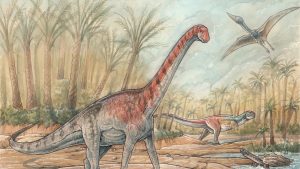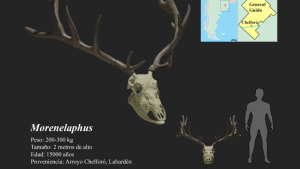A giant bear of the late Pleistocene was found in Buenos Aires
It was discovered on the banks of the Salado River, northwest of the province of Buenos Aires, a paleontological site has revealed a lot of fossils in recent weeks. The skull and jaw of this giant bear were almost complete (see video).
The paleontologist of the Museo La Plata and CONICET Leopoldo Soibelzon, who presented the largest bear in record in 2011 and have now studied this new specimen, said to the CTYS-UNLaM Agency: "find a bear in any The place of the Pampean region is an extraordinary find. "
"Finding a carnivore already is an extraordinary finding because they are always fewer in ecosystems," said Dr. Soibelzon. He added: "And within carnivores, the bears are not frequently found, and even less a complete skull with a jaw, as was found now in Junin. "
In this sense, the specialist in the study of giant bears affirmed that "it is an excellent material, because the most frequent thing is to find a tooth, a canine, a phalanx, a piece of a long bone, but finding a complete skull with jaw is very interesting".
The MLP and CONICET researcher pointed out that this bear belongs to the genus of the Arctotherium, among which is the largest specimen of the record. "This material from Junín surely corresponds to the late Pleistocene, with an age that does not exceed 120 thousand years, while giant bears of greater size existed in South America during the early Pleistocene, almost a million years ago."
The largest specimen known, belonging to the species Arctotherium angustidens, was a carnivore-omnivore that lived 780 thousand years ago and was discovered in the city of La Plata. "Since the middle of the Pleistocene, the bears were decreasing in size and, within their omnivorous diet, they were becoming a little more herbivores, but in comparison to the size of the current bears, this copy of Junín was also gigantic," said Dr. Soibelzon.
Professor José María Marchetto, director of the Museo del Legado del Salado de Junín, explained to the CTyS-UNLaM Agency that "this practically complete skull is missing what would be the right cheekbone, the zygomatic arch and part of the maxilla; then, it has even the two mandibular branches, although it also lacks the piece that joins both mandibles."
For his part, Dr. Luciano Brambilla, a biologist at the National University of Rosario, agreed that "it is extraordinary to find a fossil bear, but strikingly, in Junín, another specimen had been found decades ago; it's as if two needles had been found in a haystack. "
The director Marchetto commented that the deposit is located on the edge of the Salado River, in the section that connects the Gómez Lagoon with the Carpincho Lagoon. "It's a pretty big area, which stretches about 10 kilometers," he described.
"We are working together with the municipality of Junín to ensure that this site is declared a reserve," said the director of the Museum. He added: "The project was stalled at the time in the Chamber of Deputies and, now, the initiative is being taken up so that it not only protects the paleontological site, but also the flora and fauna of the place."
Meanwhile, the finding of fossils in Junín has become constant. Last Friday, fragments of a phalanx and a metapodium were found - bones that are part of what would be the hand or leg of a saber-toothed tiger (see images).
The bear and saber-toothed tiger are presented as the most striking findings in the midst of a large number of fossils of herbivorous animals that continue to emerge in this site located northwest of Buenos Aires. There are remains of species that inhabited the Pampean region towards the end of the Pleistocene, until its extinction about 10 thousand years ago.



